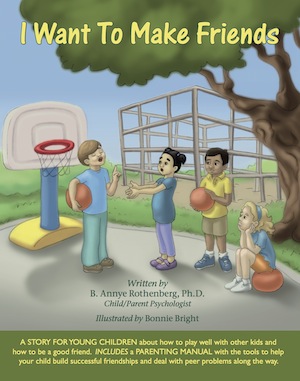|
ABOUT THE BOOK -
EXCERPT FROM THE PARENTING GUIDANCE SECTION
I Want To Make Friends
 HOW TO PLAY WITH YOUR YOUNGSTERS HOW TO PLAY WITH YOUR YOUNGSTERS
If your child always gets to choose what to play when you’re playing
with him, he may expect to always decide the activity when he’s with
parents and
peers. The child who expects to be in charge and gets resistance from a
playmate may be surprised, frustrated, and angry. He may insist on his
way. Or he may feel rejected, shut down, and just play by himself. It’s
wise for any parents playing with their child to take turns deciding
what to play, especially once a child is about two and a half years
old. Children shouldn’t be able to run the play even when
it is their turn.
Children may want to dismantle what you’re still building or tell you
what character to play or what words to say. All of this leads to
problematic assumptions of how peer (or parent-child) play should go. The
guideline to remember is: Don’t let your child do anything in playing
with you that wouldn’t work if he tried it with a peer.
TELL HER HOW HER
BEHAVIOR AFFECTS YOU
It is also important in all your
interactions with your child – not just playtime – to let her know if
something she says or does bothers you. It’s also helpful to
let her know why she just said or did that.
For example, if she keeps shouting louder and louder when you are
talking to someone else, tell her: “I know you want me to notice you,
but when you shout while I’m talking to Grandma, I get very annoyed and
then I don’t want to talk to you.” Then tell her what she could say
that would be acceptable to you: “Mom (Dad), when you
have a minute, I want to tell you something.”
Or if you announce that it’s time to pick up the toys and she says,
“You’re a mean poopy head,” let her know why you think she’s saying
that and why you’re not going to be able to be with her for a while.
Then have her practice what she should have said: “Mommy, it makes me
mad when you tell me to clean up my toys.” Just telling her how you
feel about what she just said or did isn’t enough to change behavior
(e.g., “That makes me sad”). Not
being available to her for a while is a useful consequence, and so is
having her practice better behavior – several times in a row.
We need to tell our child if her behavior annoys, angers, or saddens
us. Otherwise, she is more likely to be self-centered, less empathetic,
and less able to control her unlikeable behavior – now and in the
future.
TEACHING A CHILD
HOW TO TAKE TURNS IN CONVERSATION
Most
young children do not naturally understand about taking turns in
conversations.
Many just keep talking and talking. We may find ourselves checking out
mentally, giving our kids only half-attention. But if we don’t teach
children to let others talk, it’s harder for peers to want to be with
our child. As we know, friendships for children four and older are
largely based on verbal communication, not just activities like chasing
each other.
If
your child is developing the habit of nonstop talking, say something
like, “Hey, I don’t want to just listen. I have something I want to say”
(or “ask you about”). Then take your turn. As he goes back to too much
talking, tell him to ask you if you want to hear any more about that. Make sure you say no at
least half the time.
Tell him about something, but take breaks to ask him if he wants to
hear more. That models more sensitive and respectful communication.
Also teach him to ask you questions like “How was your day, Daddy?”
“What happened today, Mommy?” Teach him to say something complimentary
about you – “I like your shirt, shoes, etc.” – and to do that with kids
as well. Teach him to ask the kids questions: “Did you get an owie?”
when they have a Band-aid – and to share something relevant: “I fell
off my scooter and got a scrape, but it’s better now.” You can make
some of these suggestions quietly to him when he’s going to school or
playdates. Incorporating
empathetic turn-taking into your interaction with him is more effective
than just telling him how to behave.
|

